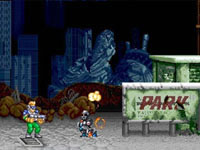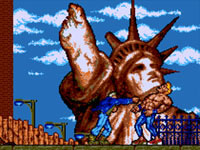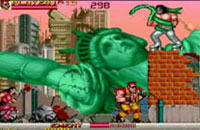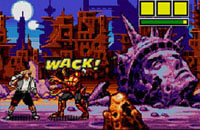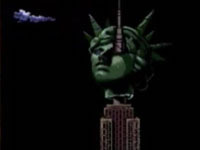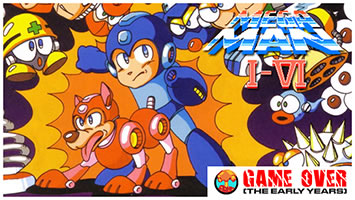- CLASSIC MAGAZINES
- REVIEW CREW
A show recapping what critics thought back
when classic games first came out! - NEXT GENERATION'S BEST & WORST
From the worst 1-star reviews to the best
5-stars can offer, this is Next Generation! - NINTENDO POWER (ARCHIVE)
Experience a variety of shows looking at the
often baffling history of Nintendo Power! - MAGAZINE RETROSPECTIVE
We're looking at the absolutely true history of
some of the most iconic game magazines ever! - SUPER PLAY'S TOP 600
The longest and most ambitious Super NES
countdown on the internet! - THEY SAID WHAT?
Debunking predictions and gossip found
in classic video game magazines! - NEXT GENERATION UNCOVERED
Cyril is back in this spin-off series, featuring the
cover critic review the art of Next Generation! - HARDCORE GAMER MAGAZING (PDF ISSUES)
Download all 36 issues of Hardcore Gamer
Magazine and relive the fun in PDF form!
- REVIEW CREW
- ELECTRONIC GAMING MONTHLY
- ELECTRONIC GAMING MONTHLY RANKS
From Mario to Sonic to Street Fighter, EGM
ranks classic game franchises and consoles! - ELECTRONIC GAMING MONTHLY BEST & WORST
Counting down EGM’s best and worst reviews
going year by year, from 1989 – 2009! - ELECTRONIC GAMING BEST & WORST AWARDS
11-part video series chronicling the ups and
downs of EGM’s Best & Worst Awards!
- ELECTRONIC GAMING MONTHLY RANKS
- GAME HISTORY
- GAME OVER: STORY BREAKDOWNS
Long-running series breaking down game
stories and analyzing their endings! - A BRIEF HISTORY OF GAMING w/ [NAME HERE]
Real history presented in a fun and pithy
format from a variety of game historians! - THE BLACK SHEEP
A series looking back at the black sheep
entries in popular game franchises! - INSTANT EXPERT
Everything you could possibly want to know
about a wide variety of gaming topics! - FREEZE FRAME
When something familiar happens in the games
industry, we're there to take a picture! - I'VE GOT YOUR NUMBER
Learn real video game history through a series
of number-themed episodes, starting at zero! - GREAT MOMENTS IN BAD ACTING
A joyous celebration of some of gaming's
absolute worst voice acting!
- GAME OVER: STORY BREAKDOWNS
- POPULAR SHOWS
- DG NEWS w/ LORNE RISELEY
Newsman Lorne Riseley hosts a regular
series looking at the hottest gaming news! - REVIEW REWIND
Cyril replays a game he reviewed 10+ years
ago to see if he got it right or wrong! - ON-RUNNING FEUDS
Defunct Games' longest-running show, with
editorials, observations and other fun oddities! - DEFUNCT GAMES QUIZ (ARCHIVE)
From online quizzes to game shows, we're
putting your video game knowledge to the test!- QUIZ: ONLINE PASS
Take a weekly quiz to see how well you know
the news and current gaming events! - QUIZ: KNOW THE GAME
One-on-one quiz show where contestants
find out if they actually know classic games! - QUIZ: THE LEADERBOARD
Can you guess the game based on the classic
review? Find out with The Leaderboard!
- QUIZ: ONLINE PASS
- DEFUNCT GAMES VS.
Cyril and the Defunct Games staff isn't afraid
to choose their favorite games and more! - CYRIL READS WORLDS OF POWER
Defunct Games recreates classic game
novelizations through the audio book format!
- DG NEWS w/ LORNE RISELEY
- COMEDY
- GAME EXPECTANCY
How long will your favorite hero live? We crunch
the numbers in this series about dying! - VIDEO GAME ADVICE
Famous game characters answer real personal
advice questions with a humorous slant! - FAKE GAMES: GUERILLA SCRAPBOOK
A long-running series about fake games and
the people who love them (covers included)! - WORST GAME EVER
A contest that attempts to create the worst
video game ever made, complete with covers! - LEVEL 1 STORIES
Literature based on the first stages of some
of your favorite classic video games! - THE COVER CRITIC
One of Defunct Games' earliest shows, Cover
Critic digs up some of the worst box art ever! - COMMERCIAL BREAK
Take a trip through some of the best and
worst video game advertisements of all time! - COMIC BOOK MODS
You've never seen comics like this before.
A curious mix of rewritten video game comics!
- GAME EXPECTANCY
- SERIES ARCHIVE
- NINTENDO SWITCH ONLINE ARCHIVE
A regularly-updated list of every Nintendo
Switch Online release, plus links to review! - PLAYSTATION PLUS CLASSIC ARCHIVE
A comprehensive list of every PlayStation
Plus classic release, including links! - RETRO-BIT PUBLISHING ARCHIVE
A regularly-updated list of every Retro-Bit
game released! - REVIEW MARATHONS w/ ADAM WALLACE
Join critic Adam Wallace as he takes us on a
classic review marathon with different themes!- DEFUNCT GAMES GOLF CLUB
Adam Wallace takes to the links to slice his way
through 72 classic golf game reviews! - 007 IN PIXELS
Adam Wallace takes on the world's greatest spy
as he reviews 15 weeks of James Bond games! - A SALUTE TO VAMPIRES
Adam Wallace is sinking his teeth into a series
covering Castlevania, BloodRayne and more! - CAPCOM'S CURSE
Adam Wallace is celebrating 13 days of Halloween
with a line-up of Capcom's scariest games! - THE FALL OF SUPERMAN
Adam Wallace is a man of steel for playing
some of the absolute worst Superman games! - THE 31 GAMES OF HALLOWEEN
Adam Wallace spends every day of October afraid
as he reviews some of the scariest games ever! - 12 WEEKS OF STAR TREK
Adam Wallace boldly goes where no critic has
gone before in this Star Trek marathon!
- DEFUNCT GAMES GOLF CLUB
- DAYS OF CHRISTMAS (ARCHIVE)
Annual holiday series with themed-episodes
that date all the way back to 2001!- 2015: 30 Ridiculous Retro Rumors
- 2014: 29 Magazines of Christmas
- 2013: 29 Questionable Power-Ups of Christmas
- 2012: 34 Theme Songs of Christmas
- 2011: 32 Game Endings of Christmas
- 2010: 31 Bonus Levels of Christmas
- 2009: 30 Genres of Christmas
- 2008: 29 Controls of Christmas
- 2007: 34 Cliches of Christmas
- 2006: 33 Consoles of Christmas
- 2005: 32 Articles of Christmas
- 2004: 31 Websites of Christmas
- 2003: 29 Issues of Christmas
- 2002: 28 Years of Christmas
- 2001: 33 Days of Christmas
- NINTENDO SWITCH ONLINE ARCHIVE
- REVIEW ARCHIVE
- FULL ARCHIVE
Destroying Lady Liberty

Unlike a lot of movies with this much hype, Cloverfield ended up being a surprisingly satisfying monster movie!
So the question begged from these images becomes why are storytellers so willing to sacrifice any claim to originality by taking their shot at destroying Lady Liberty? There must be some deeper psychology in using this structure to establish social ruin more frequently than using, say, the Empire State Building. Perhaps it is the structure's allegorical significance or convenient recognizability that causes it to resonate so deeply with audiences. Whatever the case may be, like most trends in storytelling, it has found its way and home in the world of video games. Today on Defunct Games, we will look at how images of a destroyed or corrupted Statue have made cameos in three decades of gaming.
CHAPTER 1: LIBERTY IN THE STREETS
Promotional posters for John Carpenter's film Escape from New York (1981) depict an oversized Statue of Liberty head lying in the streets, dwarfing the people and cars around it. Despite its immensity, the bigger curiosity is how the heck did the head get here. Was it carried? Blown off? Bought by a maniacal antiques collector? (At least Cloverfield explains how the head winds up in lower Manhattan.) Regardless of its lack of exposition, the image must have left a mark on more than a few game programmers. Cyber-Lip (1990, Neo Geo): The Statue of Liberty has come to embody immigration; it is a beacon for the huddled masses. When masses of defective military androids come to earth, however, they can care less about tradition and quickly displace the torchbearer into the streets. In the words of our chief editor Cyril Lachel, "Cyber Lip ... doesn't offer anything new" and this background image proves it. If anything, the destroyed statue in Stage 1 inspires patriotic gamers to avenge the disgraced lady and dump android limbs into the streets in retribution.
After the War (1989, Amiga): You are Jonathan Rogers, a man desperate to escape the radiation of a post-nuclear Manhattan. In your exodus, you are confronted by thugs not smart enough to follow you to safer ground. The game was designed by a Spanish softhouse called Dimanic and this perhaps contributes to a caricaturized version of New York City replete with graffiti, pawn shops, and smutty billboards. The physics of how the Statue of Liberty's upper torso wound up on the Manhattan isle is unlikely, but sensationalism will always outweigh the science of trajectory mechanics.
Two Crude Dudes (1990, Arcade): This beat-em-up is just absurd. You throw parked cars, break walls with you fists, and even beat up a soda machine. Your protagonist clearly hates inanimate objects. The big inanimate object in the background does not seem so misplaced when you see how over-the-top the game is meant to be. Unlike After the War, the presence of this supine statue makes sense. If one man can move a car, then I guess a few fellows can easily drag a 100 ton statue through a river and into the streets.
Comix Zone (1995, Sega Genesis): Now this screen for the fighting adventure Comix Zone does a lot of things right. Not only is the head reasonably proportional to the game sprites, but it reveals the exposed skeletal frame where the copper plating has crumbled away. She does not seem to made of copper, however. Not only is she colored in ashen tones, but the spires of her crown break away as if they were stone. Well, whose to say that in the distant future we won't be able to change the atomic structure of certain materials?
Double Dragon II (1993, PC-Engine): If you're visiting a gaming site like this one then you've likely played or at least heard of Double Dragon II. Yet, many who know the game would not recognize this image taken from the Japanese PC-Engine version. While most of us played ports of Double Dragon II with scrolling text exposition, the CD rendition seen here allowed for a cinematic opening, and boy is it dark. Not only has your girlfriend been accosted and killed by thugs, but you're greeted with extremely dark landscapes of a derelict city. The most haunting of these images is the decapitated Liberty skewered on the spire of the Empire State Building - two metropolitan icons destroyed for the price of one. If that weren't haunting enough, the artist decided to impale her through the left eye. Never mind how the head got there; it's just creepy. Forget avenging your girlfriend's death. Let's find the miscreants that did this!
HOME |
CONTACT |
NOW HIRING |
WHAT IS DEFUNCT GAMES? |
NINTENDO SWITCH ONLINE |
RETRO-BIT PUBLISHING
Retro-Bit |
Switch Planet |
The Halcyon Show |
Same Name, Different Game |
Dragnix |
Press the Buttons
Game Zone Online | Hardcore Gamer | The Dreamcast Junkyard | Video Game Blogger
Dr Strife | Games For Lunch | Mondo Cool Cast | Boxed Pixels | Sega CD Universe | Gaming Trend
Game Zone Online | Hardcore Gamer | The Dreamcast Junkyard | Video Game Blogger
Dr Strife | Games For Lunch | Mondo Cool Cast | Boxed Pixels | Sega CD Universe | Gaming Trend
Copyright © 2001-2025 Defunct Games
All rights reserved. All trademarks are properties of their respective owners.
All rights reserved. All trademarks are properties of their respective owners.







